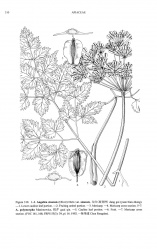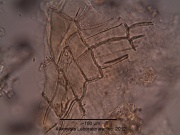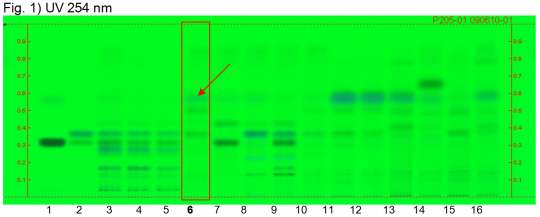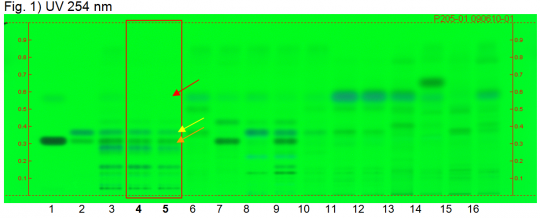Angelica sinensis (root)
(→layout) |
(Nomenclature updated) |
||
| Line 1: | Line 1: | ||
=Nomenclature= | =Nomenclature= | ||
| − | + | {{nomenclature | binomial=Angelica sinensis | |
| − | + | |authority=(Oliv.) Diels | |
| + | |family=Apiaceae | ||
| + | |scn=dong quai | ||
| + | |syn= | ||
| + | |aka=Chinese angelica; tang kuei | ||
| + | |notes=}} | ||
=Botanical Voucher Specimen= | =Botanical Voucher Specimen= | ||
Revision as of 03:45, 27 February 2014
Contents |
Nomenclature
Angelica sinensis (Oliv.) Diels Apiaceae
Standardized common name (English): dong quai
Botanical Voucher Specimen
|
Dong Quai (root) (Angelica sinensis) Flora of China Illustrations vol. 14, fig. 310, 1-4 [1] |
Microscopic Characteristics
|
High Performance Thin Layer Chromatographic Identification
|
Chinese Angelica (root) (Angelica sinensis) Lane Assignments Lanes, from left to right (Track, Volume, Sample):
Reference Sample(s) Reference:Dissolve 1 mg each of osthole and imperatorin in 10 mL of methanol. Optional: Dissolve 1 mg of Z-ligustilide in 10 mL of methanol. Stationary Phase Stationary phase, i.e. Silica gel 60, F254 Mobile Phase Toluene, ethyl acetate, glacial acetic acid 90:10:1 (v/v/v) Sample Preparation Method Sample: Mix 1.0 g of powdered sample with 4 mL of heptane and sonicate for 5 minutes, then centrifuge and filter the solutions and use the filtrates as test solutions. Detection Method Saturated chamber; developing distance 70 mm from lower edge; relative humidity 33% Other Notes Images presented in this entry are examples and are not intended to be used as basis for setting specifications for quality control purposes. System suitability test: Imperatorin: greenish fluorescent zone at Rf ~ 0.31 (UV 366 nm). Osthole: blue fluorescent zone at Rf ~ 0.36 (UV 366 nm). Identification: Compare result with reference images. The fingerprint of the test solution is similar to that of the corresponding botanical reference sample. Additional weak zones may be present. Under UV 254 nm the chromatogram of the test solution shows a blue fluorescent zone corresponding to reference Z-ligustilide (red arrow). Below this zone there are two weak quenching zones, one of them at the position corresponding to osthole. Under UV 366 nm the chromatogram of the test solution shows an intense blue white fluorescent zone corresponding to reference Z-ligustilide. Test for adulteration: Under UV 254 nm no zone is seen at or below the position of imperatorin. Under UV 366 nm no zone is seen at or below the position of osthole (Angelica root, Dahurian Angelica root, Doubleteeth pubescent root, Lovage root, Chinese lovage root. Source: HPTLC Association [3] |
|
Angelica (root) (Angelica archangelica) Lane Assignments Lanes, from left to right (Track, Volume, Sample):
Reference Sample(s) Reference: Dissolve 1 mg each of osthole and imperatorin in 10 mL of methanol. Optional: Dissolve 1 mg of Z-ligustilide in 10 mL of methanol. Stationary Phase Stationary phase, i.e. Silica gel 60, F254 Mobile Phase Toluene, ethyl acetate, glacial acetic acid 90:10:1 (v/v/v) Sample Preparation Method Sample: Mix 1.0 g of powdered sample with 4 mL of heptane and sonicate for 5 minutes, then centrifuge and filter the solutions and use the filtrates as test solutions. Detection Method Saturated chamber; developing distance 70 mm from lower edge; relative humidity 33% Other Notes Images presented in this entry are examples and are not intended to be used as basis for setting specifications for quality control purposes. System suitability test: Imperatorin: greenish fluorescent zone at Rf ~ 0.31 (UV 366 nm). Osthole: blue fluorescent zone at Rf ~ 0.36 (UV 366 nm). Identification: Compare result with reference images. Under UV 254 nm the chromatogram of the test solution shows quenching zones corresponding to references imperatorin and osthole (Rf ~ 0.31 and Rf ~ 0.36, orange and yellow arrow). Below these zones several quenching zones are detected. Under UV 366 nm the chromatogram of the test solution shows a dark blue fluorescent zone corresponding to the reference osthole. Right below a greenish fluorescent zone corresponding to imperatorin is detected. Below this zone several blue fluorescent zones are detected. Test for adulteration: No zone is seen at or directly below Rf ~ 0.57 (red arrow) (Chinese Angelica root, Dahurian Angelica root, Doubleteeth pubescent root, Lovage root, Chinese lovage root). Source: HPTLC Association [4] |
Other Points of Interest
References
- ↑ Tropicos.org. Missouri Botanical Garden. 06 Aug 2013 <http://www.tropicos.org/Image/73055>
- ↑ Elan M. Sudberg, Alkemist Laboratories http://www.Alkemist.com
- ↑ HPTLC Association http://www.hptlc-association.org/
- ↑ HPTLC Association http://www.hptlc-association.org/




